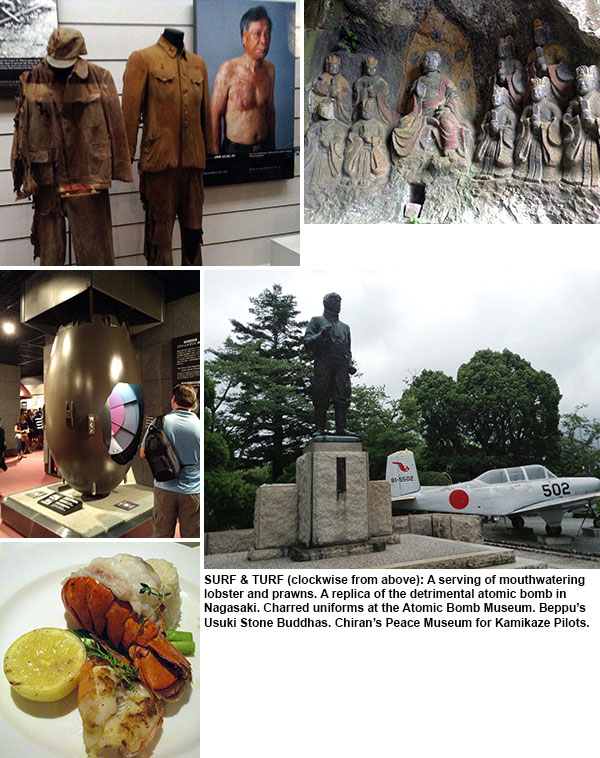Typhoon deflected: Let’s cruise on!
MANILA, Philippines - A mega typhoon with forecasted rains and winds of magnitude proportions was expected to sweep across Japan as we embarked on a nine-night cruise of its ancient capitals aboard the Diamond Princess.
However, the bright scorching sun greeted us at the Haneda Airport in Tokyo and remained shining through ‘til our transfer to the busy embarkation port of Yokohama. “But don’t be fooled. I’m warning you,” we overheard a pessimist, “it’s the perfect weather before the havoc of a storm.”
Last to cross the gangplank, we were hurriedly ushered to our respective staterooms, where we quickly grabbed our assigned life vests, to join the co-passengers for the required emergency drill. Right after mastering all the necessary details, I confidently returned to my cabin relaxed and determined more than ever to enjoy yet another cruise.
Waiting to be read was a letter from the concerned captain on the looming typhoon, detailing the revisions on the originally designed itinerary. We were now on the northwest track, instead of heading south.
Another adjustment was an extension of a couple of days at sea, of which I am not a fan. I enjoy more time at ports with interesting shore excursions.
As I studied the first of a series of Princess Patter, the daily guide to our life at sea, I whispered a prayer, resolved to remain positive. I soon heard the bells. Amen.
Excitement was in the air when we finally docked at our first port of call: Beppu, a sought-after destination, famous for thermal restorative baths.
We opted for more than an hour’s drive to the historical and the cultural city of Usuki, known for the impressive Usuki Stone Buddhas, beautifully carved from hardened volcano ash in several clusters spread on extended cliffs. Fifty-nine of these statues have been designated as National Treasures of Japan, undoubtedly a deserved honor.
We then proceeded to the Usuki Castle Ruins, situated on a strategic hill within a park of a thousand cherry trees. Built in the 1500s by a shogun, it was initially composed of a castle tower and 31 other structures. The ruins truly offer a glimpse of the lifestyle of the era.
Our next port was Kagoshima and our tour of choice was to the town of Chiran, a suburb known as the kamikaze base during the Second World War. As we silently walked around the Chiran Peace Museum for Kamikaze Pilots, we gasped in amazement and reflected on the collection of recovered aircraft, pictures of every single pilot of the Special Attack Corps complete with their mementoes.
We later strolled down the lanes of old yet well-preserved 18th and the 19th century Samurai residences with their expressive, harmonious, dry little gardens, made mainly of rocks and stones – the essential component of the entire space – masterfully arranged with trees and plants, bushes and scrubs and, in some, flowers. Designated as National Cultural Properties, it has been selected as one of the most beautiful historic locations in Japan.
Busan, the largest sea port city of South Korea, was our only Korean destination. Being its summer capital bursting with energy and known for its beaches and hot springs, its parks and mountains, its cultural activities and tempting shopping, we visited the Bulguksa Temple, completed in the 700s, and its tranquil surroundings, which boasts of a number of National Korean Treasures and is listed as a UNESCO World Heritage Site.
Induced with a deep sense of serenity and perhaps spirituality, we then moved to the 35-hectare United Nations Memorial Cemetery, the final resting place for those who bravely defended their cause and ultimately sacrificed their lives during the Korean War.
Our final shore excursion was around Nagasaki, situated on a number of hills overlooking a deep water bay, which provided inspiration for Puccini’s classic but rather modern opera Madame Butterfly.
Like hundreds of thousands – make that millions – before us, our targets for the day were two memorials: the Nagasaki Atomic Bomb Museum and the adjacent Peace Memorial Park.
Among the many delicately conserved artifacts in the museum that more than just caught our attention was the shattered wall clock that eternally stopped at 11:02 a.m., the rice in a school girl’s lunch box burned due to the accompanying fires, work clothes charred black by the heat rays, the bones of a hand in a glass and a helmet with remains of a skull, and the life-sized model of the Nagasaki-type atomic bomb that caused the entire catastrophe.
Searching for the much-desired fresh air, we braved the rain – remnants of the storm, remember? – and moved to the Peace Memorial Park with a solemn monument that marks the hypocenter of the atomic bomb and the imposing 30-foot tall Statue of Peace.
The return trip to the port was void of the usual chatter. It was one of deafening silence, with our private thoughts and recollections, with sincere unspoken hopes that another day such as Aug. 9, 1945 will never see light.
Despite the anticipated, imminent heavy storm, itinerary rerouting and everything else in between, staying as genuinely optimistic as possible definitely went a long way.
Additional days at sea provided more appreciation for the boat’s unparalleled amenities and implausible features. It likewise served as a new page for greater realizations and excellent opportunities such as flowering of new friendships, better understanding of friends through intimate bonding, noteworthy interactions with the genuinely accommodating crew and extra moments of relaxation and discovering more about oneself.
As they say, “Good things come to those who cruise.”
- Latest
- Trending


















